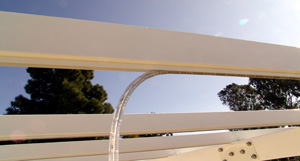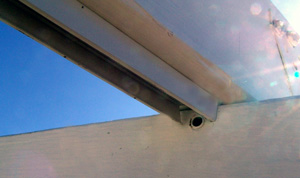

Key to the design is the white LED ropelight. It is wound around the support posts and runs the length of the underside of each rafter. The type of ropelight used runs off of 12VDC. The LEDs are placed every one inch and all point out the side of the 1/2-inch diameter ropelight in the same direction. This ropelight can be cut in 3-inch increments. White LED ropelight is the most expensive kind of ropelight made at about $5/foot. Incandescent ropelight is much cheaper, but draws much more power, usually requires 110VAC making wiring much more difficult, has a shorter lifetime, and canít be cut in such short increments.
As previously mentioned, the ropelight on the support posts fits into the half-round routed grooves and is fastened with stainless brads. The ropelight that runs the lengths of the rafters snaps into a plastic track made for that purpose that is attached to the bottoms of the rafters. The track is first painted because if left the natural clear that it comes in it will soon turn amber in the sunlight. Krylon makes a white spray paint for plastics that works nicely for this purpose.
|
|
|
Ropelight power connectors are bulky so I made my own using Wire-Wrap pins. Short lengths of Teflon insulated wire connect each length of ropelight to a common wire bus located in the gap between the beams. These wire enter the gap through 1/4-inch stainless steel tubing sleeves passing through the beams.

|
|
|
The ropelight I chose had serious quality problems and gave me a great deal of trouble. That story is here..
|
|
|
The roplight is powered with a 12VDC 150W switching power supply, Astrodyne RS150-12. The entire patio cover, ceiling and posts, draws only 120 watts of power. The power supply is located in a laundry room cabinet.
|
|
|
The LED ropelight actually is much more stunning when seen in person. The human eye has better resolution and dynamic range than an 8 megapixel camera and can easily resolve each individual LED, even at a distance.